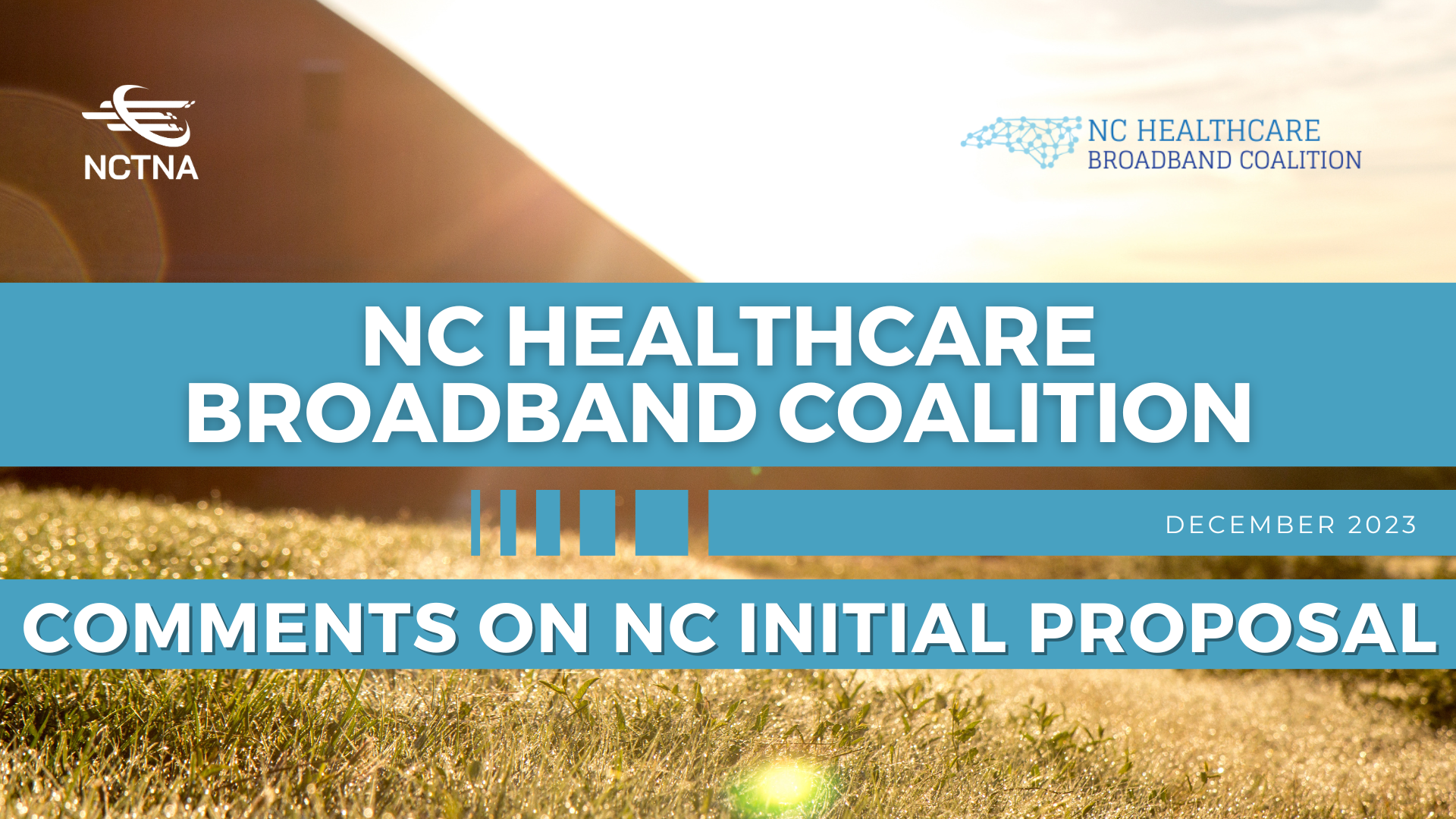NCHBC COMMENTS ON NC INITIAL PROPOSAL
DECEMBER 2023
The NC Healthcare Broadband Coalition (NCHBC) welcomes the opportunity to submit comments for the NC Division of Broadband and Digital Equity to consider as it refines its drafts of the NC Initial Proposal. With these comments, the NCHBC supports positive, key aspects of the current version of the Proposal, and it provides observations and recommendations intended to strengthen the current draft.
The NCHBC is an association of healthcare, public health, and rural NC members. These include the NC Healthcare Association, the NC Association of Local Health Directors, the NC Community Health Center Association, the NC Rural Center, the Office of Rural Health, AHEC, the NC Regional Council of Governments, UNC Health System and ECU Health, health systems with large rural presences, MCNC, and Benchmark (a behavioral health association). It’s purpose is to inform NC’s frontline healthcare providers about NTIA and NC broadband funding activities, and to partner with the division, providing it with feedback, accelerating data collection, and assisting digital inclusion activities.
Overall, NCHBC believes that the Proposal sets the state up for a successful allocation of funding and deployment of broadband infrastructure to last mile residents, small businesses, and Community Anchor Institutions (CAI). In particular, the Proposal’s reliance on the division’s existing broadband funding infrastructure and programs provides a reliable foundation, based on practice and experience, that gives the state a leg-up as it solicits applications, evaluates proposals, allocates funds, and monitors BEAD-related programs. In particular, we believe the NC Center for Geographic Information and Analysis and the NC Geographic Information Coordinating Council along with existing address-related data sets, and the mapping capabilities of the Division itself will be essential if we are to accurately identify underserved and underserved residents, small businesses, and CAI’s.
NCHBC works with several broadband organizations around the country, and all have recognized the importance of policy (e.g. pole attachment policy) and workforce to the successful rollout of the BEAD program. We are glad to see that the division plans to request support from the legislature and to leverage other agencies, community colleges, and nonprofits to address these issues.
NCHBC supports the division’s approach to assuring the financial health of applicants. Using multiple approaches and documents, rather than relying on a letter of credit, enables smaller broadband providers who may not be able to secure a letter of credit to participate in the BEAD program.
As a representative of the state’s healthcare and public health organizations, we appreciate the division’s recognition that healthcare is fundamentally dependent on broadband for its internal operations, information sharing among healthcare providers, and the practice of telehealth. This means that ultimately, the expansion of broadband promotes the expansion of access to high-quality healthcare. We appreciate the division’s recognition that healthcare organizations are central community anchor institutions and important broadband stakeholders in North Carolina. Specifically, we support the division’s adoption of the BEAD NOFO language that CAI’s include “health clinics, health centers, hospitals, and other medical providers”.
The NTIA recognizes that CAI’s with less than 1 gigabit-level broadband service are prioritized locations (after the unserved and underserved residential and small businesses.) At the same time, the FCC National Broadband Map only includes locations where mass-market fixed broadband is or could be available. It also assumes that most CAI’s subscribe to customized, enterprise-grade internets service, not to mass market services. This means that many CAI’s do not show up on the map at all and many others are misidentified as residences or small businesses. By way of example NCHBC engaged in an earlier challenge and found that about 2/3 of it’s member facilities were mis-identified or excluded from the map altogether. Fortunately NTIA guidance allows our state broadband office the flexibility to define and gather information on the CAI’s in its jurisdiction. As we’ve note above, health organizations have been identified as CAI’s in the NC Initial Proposal, and a range of efforts are underway to identify the NC CAI’s including healthcare organizations. However, there are significant gaps. In particular, no initiative has been identified to inventory non-governmental healthcare organizations, to ascertain which actually use mass market services and has less than a gigabit bandwidth, and to correct their representation on the broadband maps used by the state to allocate funds. We recommend that the division identify ways in which to gather this information and address this gap. The NCHBC is glad to work with the division to address this issue.
The NC BEAD Five-Year Action Plan recognizes that extensive collaboration with community agencies and stakeholders is important in planning for funding applications and deployment projects. The NCHBC recommends that local healthcare providers (and other community CAI’s) be included as part of the community engagement guidance encouraging their participation in community needs and impact assessments and in county funding application review.
As potential participants in the state’s challenge process, some healthcare providers may not be aware of the challenge process and their potential role as a non-profit or as an anchor and challenge collaborator in a municipality. It would be helpful if the division could develop a communications/instructional strategy to inform providers about their role and about the workings of the challenge process. NCHBC would be happy to work with the division on this.
NCHBC recommends that healthcare organizations (and other CAIs) be considered as part of a county’s broadband deployment plan, depending on community and ISP needs and on the priorities and capacity of the healthcare organization. One possibility is to deploy broadband services “to and through” healthcare provider organizations. The healthcare anchor might be connected to a middle-mile circuit and distribute last-mile connections to the home with fiber or fixed wireless. This could be a more efficient and less expensive solution. A second option is to include healthcare organizations on a community network as “anchor tenants” to help “subsidize” the connectivity of other homes on the network. Finally, healthcare organizations are often first-responders during natural disasters like hurricanes. Particularly in rural coastal plain counties, healthcare organizations (and other CAIs) might be incorporated into a community network as a redundant connection that can be leveraged during a natural disaster. As an example, a healthcare organization could access a satellite connection and broadcast fixed wireless connections to priority sites. In general, while anchor institutions are prioritized after unserved and underserved residents and small businesses, this does not mean that they should be connected after all unserved and unserved locations are, but they should be connected when it makes economic and technical sense.
Finally, we believe that many healthcare organizations can be effective participants in wider digital inclusion activities. Examples include used device refurbishing and recycling, digital health literacy training, and collaboration with other anchors to promote telehealth and greater healthcare access.
The NCHBC believes the BEAD funding represents a watershed for North Carolina’s healthcare organizations and its patients. We believe the plan represents a solid first step in the state’s deployment of these funds, and we appreciate the opportunity to provide comments. We look forward to the Initial Proposal’s s next iteration and to continued partnership with the division.





